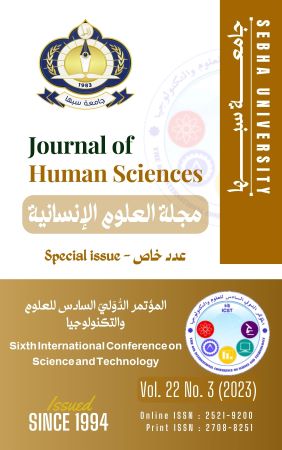Spatial analysis of the distribution of basic education schools in the city of Ubari for the academic year 2022-2023
Main Article Content
Abstract
This research seeks to study the spatial distribution of basic education schools in the city of Ubari for the academic year 2022-2023 AD and its development since the beginning of the application of formal education in the study area and to know the main factors affecting this distribution, as well as to shed light on the planning standards for the distribution of these schools and to know the extent to which they conform to planning standards at the national level, and the research relied on the descriptive analytical approach in collecting, presenting and analyzing the data and information contained in the content of this research, and the systems program was also used Geographic information (arcmap10.8) for the purpose of spatial analysis of the distribution of basic education schools in the study area, such as knowing the general direction of this distribution and its concentration, as well as knowing the pattern of this distribution by extracting the nearest neighbor and the standard distance, in addition to knowing the scope of service of these schools within the city and knowing the areas outside the scope of this service; The results also showed that the most important factors affecting the distribution of basic education schools in the city of Ubari and their concentration in a limited area within the city is the government's policy imposed in preventing the construction of schools outside the city's urban plan, in an attempt to encourage residents to move and live within the planned area in the city so that the distribution of all social and economic services is easier for the population within the city, as well as not to establish basic education schools. The study also found that the number of schools in the city conforms to the planning standards in terms of the population criterion, but it was found that there is a deficiency in the criterion of the distance traveled by the student to reach the school for some residential neighborhoods, as this distance far exceeded what is in the national planning standards, and the results showed that there are many areas in the city outside the scope of serving basic education schools.
Downloads
Article Details
Plagiarism policy
Sebha University Journal respects intellectual property and aims to protect the original work of authors applying for publication. In general, the laws of the magazine are inconsistent with scientific articles that contain stolen materials and are not bound by the standards of quality, research and innovation. Applicants for publication to the journal must adhere to ethical standards and refrain from plagiarism in any way. In the event that any plagiarism or scientific theft of an article submitted for publication is found, the journal will contact the author to provide their interpretation within two weeks of its date, after which it will be referred to the relevant committees formed for this purpose to take strict measures. about that. In general, the journal’s license allows the citation of the content published on its website and the download of all files.




